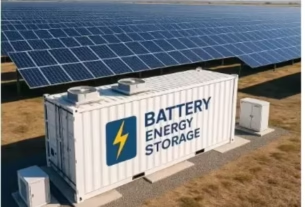In Short : India is rapidly scaling up its renewable energy infrastructure to achieve its ambitious target of 500 GW of non-fossil fuel capacity by 2030. Beyond deployment, domestic manufacturing capacity is now emerging as a cornerstone of the transition. Building strong local supply chains for solar panels, wind turbines, and batteries is crucial to reduce import dependence, create jobs, and strengthen energy security. These three sectors form the backbone of India’s clean energy economy, driving both new installations and storage solutions.
Solar Panel Manufacturing Capacity
- Current Status: India has built a sizable solar manufacturing base, with multiple facilities producing solar modules and cells.
- Capacity Scale:
- Annual installed capacity of solar PV modules runs into several gigawatts.
- Solar cell capacity lags behind, creating a dependency on imports to bridge the gap.
- Growth Drivers:
- PLI schemes, customs duties on imports, and Atmanirbhar Bharat policies are boosting domestic production.
- Upcoming gigafactories aim for integrated production — from polysilicon to finished modules.
- Future Outlook: India is expected to become self-reliant in solar manufacturing, with growing export potential.
Wind Turbine Manufacturing Capacity
- Current Status: India is among the world leaders in wind turbine manufacturing, supported by a robust domestic supply chain.
- Capacity Scale:
- Annual capacity can support several gigawatts of new wind installations.
- Domestic and global companies manufacture nacelles, blades, towers, and gearboxes locally.
- Strengths:
- Wind energy is one of the most indigenized renewable technologies in India.
- Strong logistics and port infrastructure support coastal and offshore projects.
- Future Outlook: The push for offshore wind projects will create demand for advanced turbines, spurring further capacity growth.
Battery Manufacturing Capacity
- Current Status: India’s battery sector, especially lithium-ion, is still at an early stage.
- Capacity Scale:
- Small-scale assembly plants exist, but large gigafactories are being developed.
- Demand is growing rapidly due to electric vehicles (EVs) and energy storage systems (ESS).
- Growth Drivers:
- The PLI scheme for Advanced Chemistry Cell (ACC) batteries is enabling giga-scale manufacturing.
- Several domestic and foreign firms have announced multi-GWh investments.
- Challenges:
- Heavy reliance on imported raw materials such as lithium and cobalt.
- Need for indigenous R&D in next-gen chemistries to stay globally competitive.
- Future Outlook: India is poised to become a major global battery manufacturing hub over the next decade.
Comparative Perspective
| Sector | Current Status | Strengths | Challenges | Future Outlook |
|---|---|---|---|---|
| Solar Panels | Strong manufacturing base for modules; weaker in cells | PLI schemes, emerging gigafactories | Import dependency for upstream materials | Moving toward self-reliance + exports |
| Wind Turbines | Mature and indigenized | Robust domestic supply chain, logistics support | Offshore tech still evolving | Capacity to expand with offshore demand |
| Batteries | Nascent but growing | Policy push (PLI-ACC), large investments announced | Raw material imports, limited R&D | Expected to scale rapidly into a global hub |
Conclusion
India’s renewable manufacturing ecosystem is expanding across solar, wind, and batteries. Solar and wind already enjoy strong domestic foundations, while the battery sector is emerging as the next growth engine of clean energy. With supportive policies, investments, and innovation, India is positioning itself to not only meet domestic demand but also become a global hub for renewable energy manufacturing, enhancing both energy security and economic growth.




